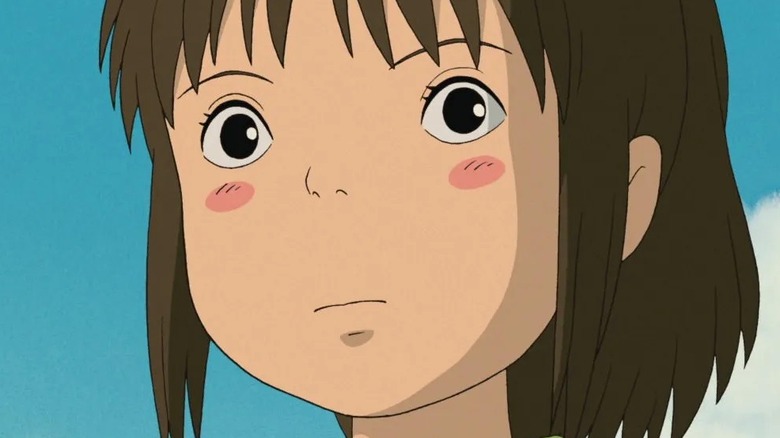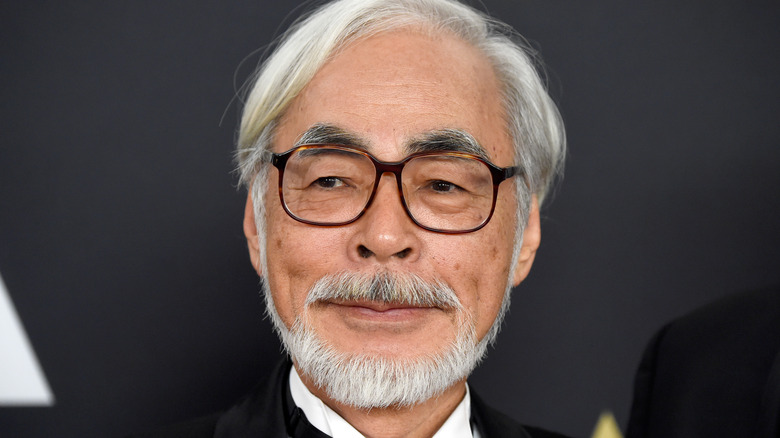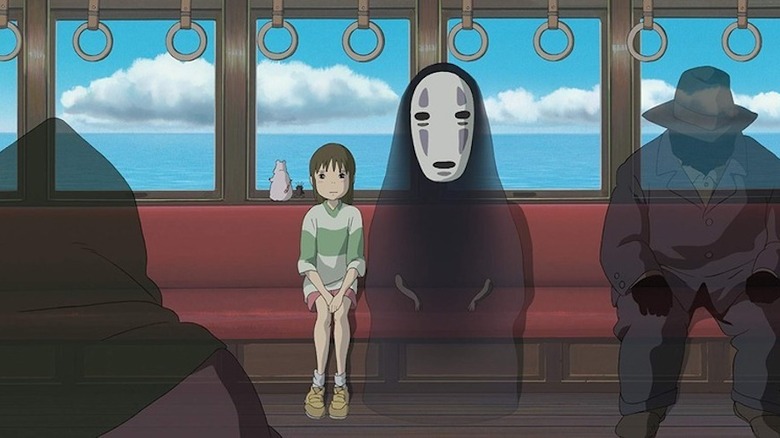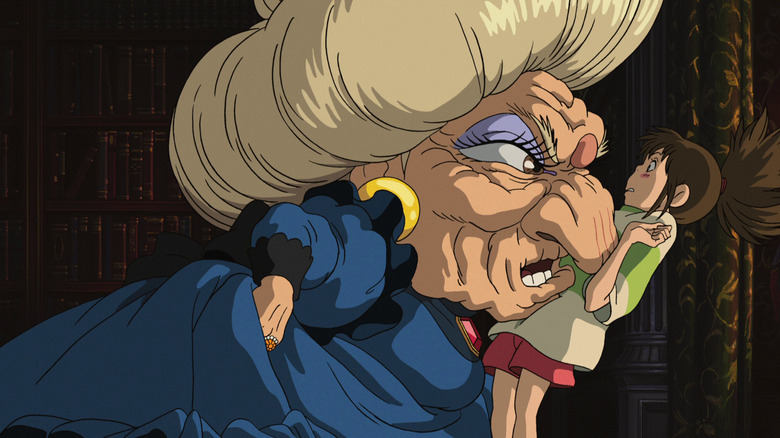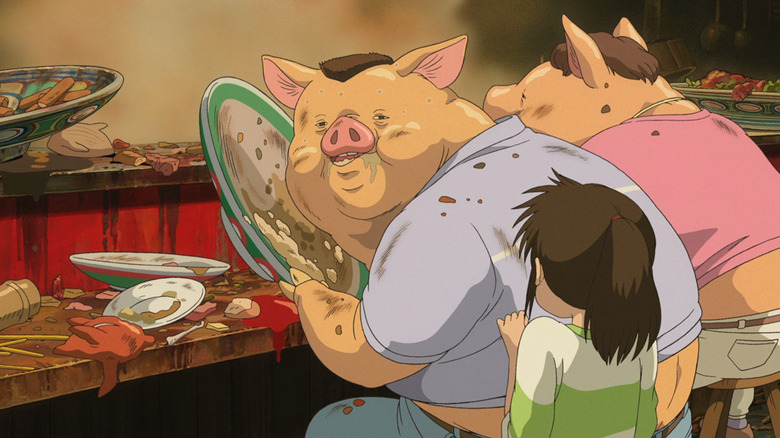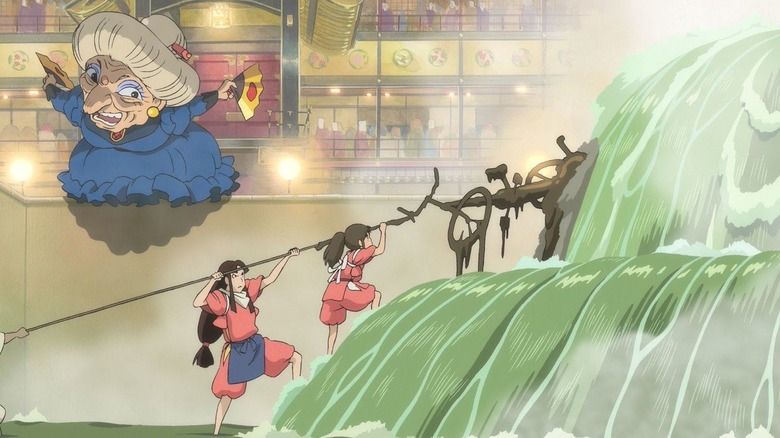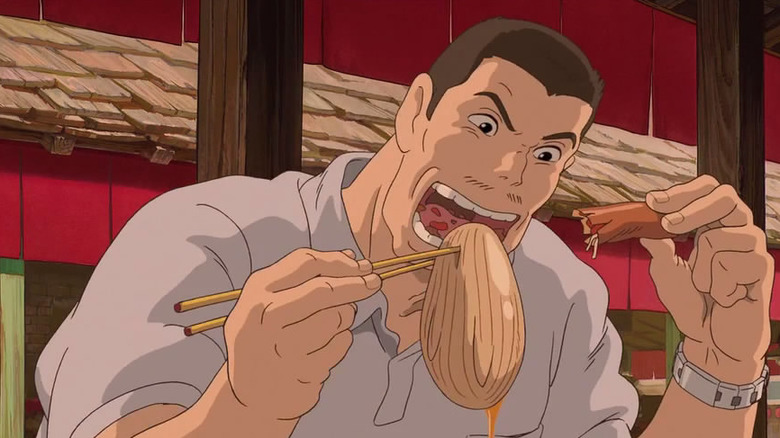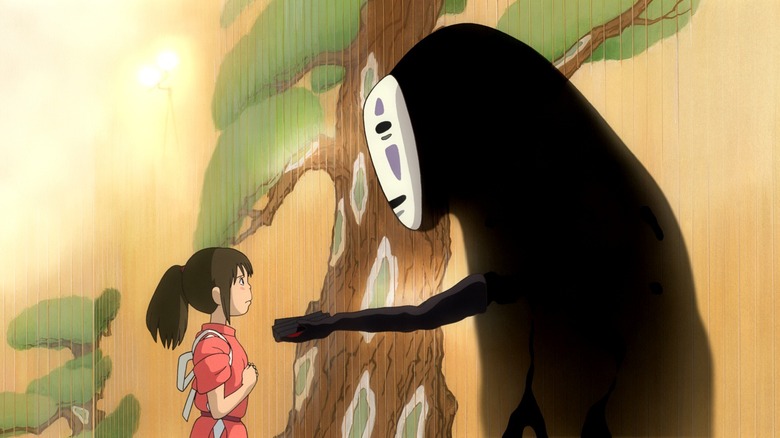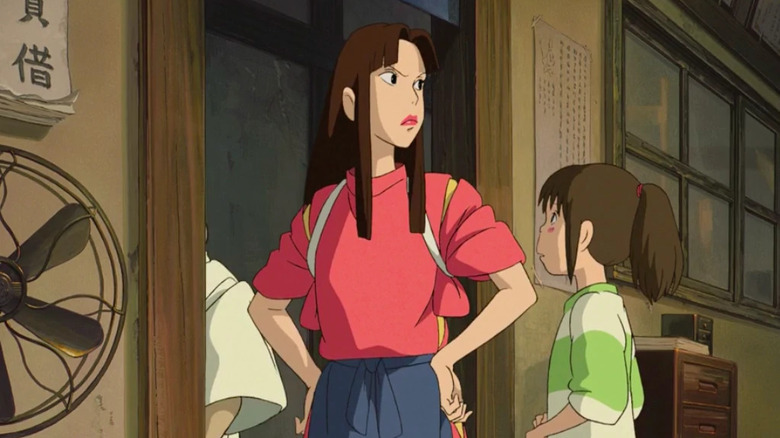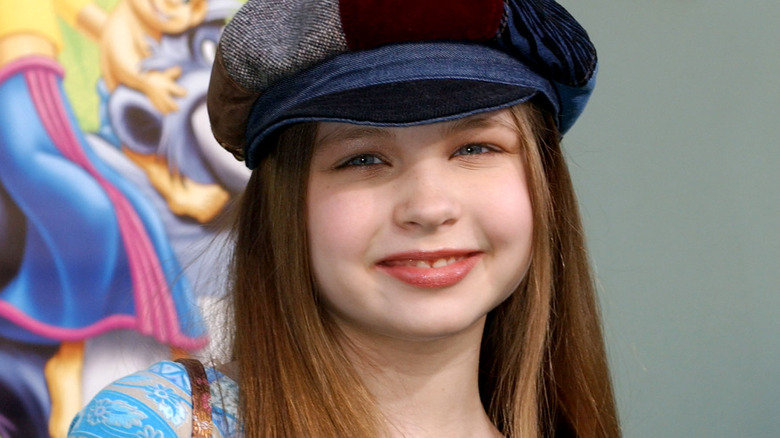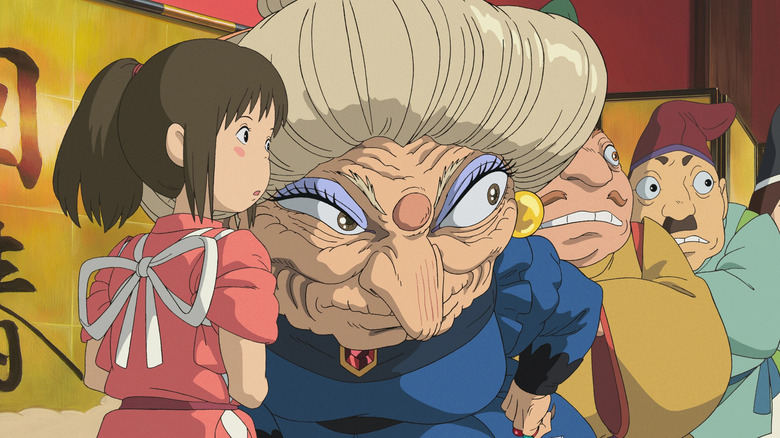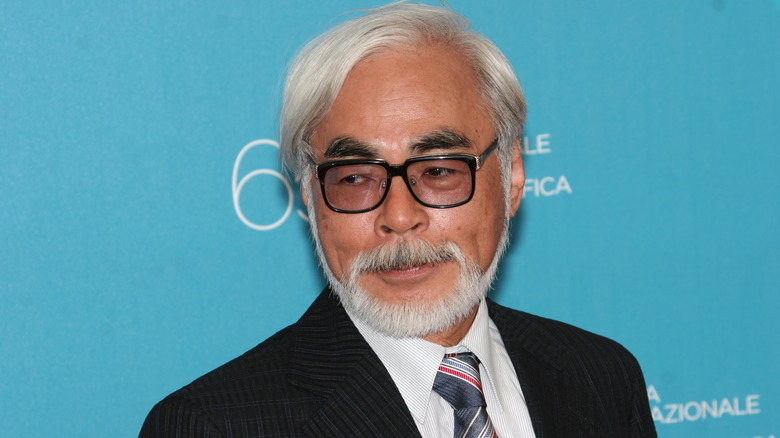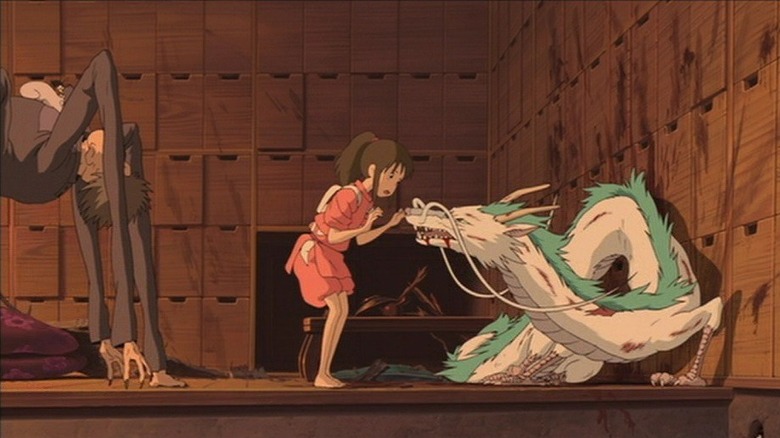The Untold Truth Of Spirited Away
Hayao Miyazaki's "Spirited Away" has had an indelible effect on popular culture worldwide. Following its release in 2001, the film went on to win Best Animated Feature at the Academy Awards, making it the first non-English language movie to do so. It was the highest-grossing film in Japan for nearly 20 years and one of the first films to get audiences worldwide to take animation seriously as an art form. Distributed by Disney in the United States, the film also became a hit with American children and adults alike.
The film's visual language and storytelling style is like nothing else we'd seen before (apart from Miyazaki's other films, of course), and a scene-by-scene breakdown of the film's many symbolic narrative elements could fill an entire book. If you've clicked on this article, we're going to assume you're already a fan of the film yourself, so there's no need to break down the story for you. Instead, we thought it might be fun to have a look at all the hard work that went into making the movie. Think you know everything there is about Miyazaki's masterpiece? Well, think again. Keep reading to discover the untold truth of "Spirited Away."
Miyazaki made Spirited Away for a very specific audience
While "Spirited Away" is beloved by viewers of all ages, Hayao Miyazaki had a very specific audience in mind when he was developing the film. In a 2001 interview with Animage, Miyakazi discussed the intended viewership of his most famous films. "We have made '[My Neighbor] Totoro,' which was for small children, 'Laputa,' in which a boy sets out on a journey, and 'Kiki's Delivery Service,' in which a teenager has to live with herself," he explained. He went on to say that they hadn't yet made a movie for 10-year-old girls, which was his intention in bringing "Spirited Away" to life.
Miyazaki explained that he had five family friends who he would spend the summer with every year that were around protagonist Chihiro's age in the film, and he wanted to make a movie that they could enjoy. "I felt this country only offered such things as crushes and romance to 10-year-old girls," he explained, adding, "and looking at my young friends, I felt this was not what they held dear in their hearts, not what they wanted. And so I wondered if I could make a movie in which they could be heroines."
Though he's certainly aware adults enjoy his films, he maintains the viewers he has in mind for most of his films are children. "Simply put, I think that a film which is made specifically for children and made with a lot of devotion, can also please adults. The opposite is not always true," he told Midnight Eye.
There was no script
It's often been said that Hayao Miyazaki makes films without writing a script, and he confirmed that this is the case in an interview with Midnight Eye. He explained that he often doesn't have the time to write an entire script before starting work on his films, saying, "So the story develops when I start drawing storyboards." He went on to explain that the schedule is so tight they usually begin production while the storyboards are still in development.
Instead of having an exact idea of where the film will go, the story naturally develops as they begin work. Miyazaki explained the process like this: "It's not me who makes the film. The film makes itself, and I have no choice but to follow." In the case of "Spirited Away," the film did indeed have a mind of its own. "There are 1,415 different shots in 'Spirited Away.' When starting the project, I had envisioned about 1,200, but the film told me no, it had to be more than 1,200," he explained. Miyazaki admitted that this strategy can be taxing for him and his animators but that anyone who works with him eventually learns to accept his demanding approach.
The characters' names all have meaning
There are a number of cultural and linguistic elements in "Spirited Away" that non-Japanese audiences likely won't pick up on. One of the most obvious aspects of the film that might go over non-Japanese speakers' heads is the meaning of the characters' names.
Obviously, every character in the film has a Japanese name, and most of these translate to a word or phrase that relates to the characters' role or profession. According to Vice, Chihiro translates to "a thousand" and "asking questions," as well as "searching or seeking." This clearly reflects Chihiro's naturally inquisitive nature. But when Yubaba makes her sign a contract, she takes a character from her original name to give her a new one, "Sen," which simply translates to "a thousand." In this way, Yubaba takes away an important part of Chihiro's identity, an act made even crueler by the fact that Chihiro gradually forgets her real name.
The other characters' names have fairly obvious translations. Yubaba translates to "bathhouse" and "old woman," essentially making her a bathhouse granny. Boh means "little boy" or "son," while Kamaji — the mustachioed man with six arms — translates to "old broiler man." The name of Yubaba's twin sister, Zeniba, means "money witch," which connects to her fury at Haku for stealing her golden seal (though we later learn she's actually a very nice lady).
Why Chihiro's parents turn into pigs
Speaking with Midnight Eye, Hayao Miyazaki was asked why both "Spirited Away" and "Porco Rosso" include characters who are turned into pigs. "That's because they're much easier to draw than camels or giraffes," Miyazaki responded, likely in jest. While there might be some truth to that answer, he then gave a more detailed explanation. "The behavior of pigs is very similar to human behavior. I really like pigs at heart, for their strengths as well as their weaknesses," he said, adding, "They're close to us."
The symbolism of pigs goes even deeper than just their similarity to humans. Several years ago, Studio Ghibli's Twitter account responded to a number of questions from fans about their most famous films, including "Spirited Away." One user asked Studio Ghibli why Chihiro's parents turned into pigs near the start of the film, and they received a detailed explanation.
As reported by Rocket24, the Twitter account explained Miyazaki said that during the 1980s, some people became pigs during the country's bubble economy, resulting in a crash in 1991. According to the explanation, this fantastical pig transformation doesn't just happen in the fantasy world — humans can transform into pigs "in body and soul" in the real world too. Clearly, there are several levels to the symbolism of pigs here, and it's up to the viewer to decide how they want to interpret the film's animalistic implications.
The inspiration for the river spirit sequence
Hayao Miyazaki is well-known for the way most of his films illustrate a concern for the environment, and "Spirited Away" is no exception. One of the most memorable (and grossest) scenes in the film occurs when a river spirit visits the bathhouse. Every being in the bathhouse can smell the river spirit as soon as it walks in because it's so putrid, and poor Chihiro is given the job of giving the world's muddiest client a bath. As she hoses down the spirit, she finds it's filled with trash and pollution, including an entire bicycle.
This scene might seem like one of the most fantastical moments in the film, but it was actually inspired by Miyazaki's own experiences with environmental cleanup. Miyazaki told Midnight Eye that he was once involved in cleaning a river near where he lives in the countryside. He described the river as disgusting because people had been throwing trash into it for so many years. One of the most unexpected discoveries was a fully intact bicycle sticking out of the water. "So they thought it would be easy to pull out, but it was terribly difficult because it had become so heavy from all the dirt it had collected over the years," he explained.
The difficulty Miyazaki and his neighbors had removing the bicycle directly mirrors Chihiro's struggle to pull the bicycle from the river spirit, as does the smell of the river itself. In this case, real life was a better source of inspiration than any mythology.
The mystery of what Chihiro's parents were eating
When employees at Studio Ghibli took to Twitter to do an informal Q&A with the fans of their films, a lot of interesting secrets were revealed. One response answered a question that had been a long-standing mystery among "Spirited Away" fans. If you've seen a few Miyazaki or Studio Ghibli projects, you're probably aware that food is hugely important to these movies. Fans are constantly drooling over the food depicted in the films or making certain dishes themselves. But there's one meal that fans have been perplexed by. When Chihiro's parents first visit the ghost town and start chowing down at a restaurant, there's a beige dish on her father's right side that fans have long wondered about.
Someone asked Studio Ghibli about the dish on Twitter, and surprisingly, they actually had an answer. "It was written on the storyboard that the soft, flabby food the dad eats is the stomach of a coelacanth," Studio Ghibli reported on Twitter (as translated by Sora News 24). What is a coelacanth, you might ask? Well, it's a large, frankly terrifying-looking fish that dates back to over 400 million years ago. We're not sure what possessed Miyazaki to include such a bizarre (and difficult to identify) dish in this scene, but it's yet another example of how the master animator is never one to skimp on the details.
The recording sessions for No-Face were hilarious
Hayao Miyazaki films are famous for not having true villains (apart from larger concepts like war and environmental destruction), and "Spirited Away" is another example of this. While No-Face might appear villainous at certain points, it becomes clear he just wants to connect with others but isn't sure how to do so. Essentially, No-Face represents all facets of human nature, whether they emerge in a negative or a positive capacity.
Despite the fact that he's not really a villain, No-Face can be pretty scary at times, especially to young children. But the experience of recording No-Face's "dialogue" was far from scary — in fact, it was the exact opposite. In celebration of the film's 20th anniversary, Studio Ghibli decided to answer some questions from fans about the making of "Spirited Away." One anecdote the studio provided was that the recording sessions for No-Face — who was voiced by Akio Nakamura in the Japanese version — were downright hilarious, with everyone constantly laughing (via CrunchyRoll).
The folks at Ghibli went on to describe the situation further, revealing the direction Nakamura was given were things like, "'Please give me an even sadder 'ah'," followed by "'An even sadder 'ah.'" Fans of the film will certainly be able to conjure up Two-Face's distinct noises after hearing this anecdote, and it's indeed hilarious to imagine Nakamura trying to make his grunts even sadder with each take.
None of the workers at the bathhouse are human
After Chihiro's parents are turned into pigs and she's left alone in this strange town after dark, she learns that it's quite literally a ghost town, and most of the residents are of the non-human variety. After Haku leads her to the bathhouse, she's left in the capable hands of Lin (known as Rin in Japanese), one of the employees. It may seem like Lin and her female co-workers are the only humans working at the bathhouse, but that might not actually be the case.
As per Studio Ghibli's Q&A with fans on Twitter (via Time Out), the idea behind the bathhouse employees is that all the male employees are frogs while all the women are actually slugs. The studio suggested the idea behind this notion may be that the bosses at Studio Ghibli tend to all look the same to new hires until they get to know them better. They proposed that the reason Chihiro sees Lin as human is because she is one of Chihiro's bosses, and her mind needs a way to distinguish her from the other employees there.
The English voice of Chihiro might sound familiar to you
One of the most compelling parts of watching animated films is being able to recognize the voices of the actors portraying your favorite characters. You can hear the voices of many popular actors in the English dubs of Studio Ghibli films. For example, "Princess Mononoke" features Gillian Anderson and Claire Danes, and "The Secret World of Arrietty" stars Tom Holland, Saoirse Ronan, and Olivia Colman in the British dub.
"Spirited Away" might not feature a ton of famous names in its English-language dub, but the voice of Chihiro might sound familiar to you if you listen closely. The actor who voiced the character in the English version is none other than Daveigh Chase, who's most famous for voicing Lilo from Disney's "Lilo and Stitch." She also played Samara in "The Ring."
She was around Chihiro's age at the time she recorded the part, and Kirk Wise, the director of the English translation, said in a behind-the-scenes featurette, "Daveigh is a wonderful, natural, actress." John Lasseter, formerly the chief creative officer at Pixar, also sung her praises, saying, "There's so much heart and personality that Daveigh brings to the character."
How the American voice actors recorded their lines
As is the case with most film dubs, the English-speaking voice actors who worked on "Spirited Away" used a process called ADR, which stands for automatic dialogue replacement. In a behind-the-scenes featurette for the film, director Kirk Wise described how each actor was shown the parts of the film they were voicing while in the recording studio.
Jason Marsden, who voiced Haku, explained that the most difficult part of the process for him was having to match the timing of the animation. "If I were to do it, maybe I would have used this line and paused a while or embellished a certain way, but I can't, I don't have time to do that because the mouth is still moving," he explained. There was room for interpretation, however, as Suzanne Pleshette, who voiced both Yubaba and Zeniba, realized she had made the opposite choice from her Japanese counterpart in voicing the sisters. She explained that she made Zeniba's voice deeper and Yubaba's voice higher, while the Japanese voice actor, Mari Natsuki, did the opposite.
While you might not recognize many of the names of the American voice actors, you may recognize some of the voices. Susan Egan, who voiced Lin (or Rin) in the film, also voiced Megara in Disney's "Hercules," and she described how useful it was to watch the film itself while recording. Meanwhile, Lauren Holly (who you might know from "NCIS"), found that the most helpful trick was to munch on an apple while recording the scene where Chihiro's mom chows down in the ghost town.
Miyazaki and his animators had a late-night dinner tradition
Considering that there were 1,415 hand-drawn frames made for the film, it's no surprise that animators working at Studio Ghibli didn't have much time to relax while they were working on a project. But despite their intense work schedule, one behind-the-scenes video from the making of the film shows us a sweet tradition the animators had. The animators had a routine of sorts where they would take turns cooking dinner for the team each night, sitting down (very briefly) to eat at around 11 PM every evening.
The footage shows that one evening, an animator made an enormous plate of spaghetti for everyone to enjoy. A few days later, it was Miyazaki's turn, and he made a dish called Poor Man's Salt-Flavored Ramen, as it read on the menu in the office. Miyazaki managed to fit 10 packets of instant ramen in the pot — a quick and easy dinner for a hungry and overworked group of animators. The team was happy to get a chance to take a break, slurping up ramen from mugs and complimenting their boss' cooking skills.
The dragon's movements were based on several different animals
Animation is an incredibly difficult and time-consuming art form, and animators working for Hayao Miyazaki have a harder job than most. He's incredibly specific about every detail in his films, as evidenced by a behind-the-scenes video illustrating the making of one scene involving Haku in his dragon form. Miyazaki knew exactly how he wanted the dragon to move, and he explained these ideas to his animators using real-life animals as examples.
First, he explained that when the dragon was thrashing around, he wanted him to stick to the wall like a lizard. But when the dragon falls, he wanted him to fall like a snake, which is to say he wanted him to hold his shape while falling but hit the ground with a loud thud. (Miyazaki was disappointed that none of his employees had ever seen a snake falling out of a tree.) During the sequence where Chihiro is trying to capture Haku, Miyazaki wanted his animators to think of an eel struggling to get away.
For the sequence in which Chihiro attempts to open Haku's mouth with her hands, Miyazaki wanted his animators to imagine a dog being forced to take a pill. When he found out none of his animators had dogs — another disappointment — he had them take a trip to the vet. While there, they watched as the vet tried to force open the mouth of a golden retriever, and they recorded the dog's movements to review later. Though it took a lot of effort to get there, Miyazaki was eventually satisfied with the final product.
